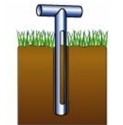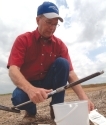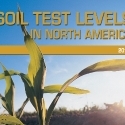08 Feb 2013
Northeastern US Soil Test P
Soil Test Summaries
The figures below use histograms to show the frequency distribution of soils sampled for the crop years 2001, 2005 and 2010. Note that a number of different soil tests are used in the region. For comparison purposes, all soil test levels have been converted to the equivalent of the Bray P1 soil test. Assumptions for equivalencies are shown in Table 1 below.
Information on crop nutrient balances is available in the new IPNI publication, A Preliminary Nutrient Use Geographic Information System (NuGIS) for the U.S.
While the 2010 survey showed a large increase in the total number of soil samples, compared to 2005 and 2001, there was little change in the distribution of soil test P levels overall, except for a slight decline in the proportion testing very high.
Michigan has seen a decrease in the frequency of soils at the highest soil test P levels. About 30% of soils tested below the 25 ppm critical level.
Ohio has a lower distribution of soil test P levels than any other state or province in the Northeast region. In the past 5 years, the frequency of soils testing in the highest ranges has declined, and the frequency of those testing below critical levels has increased. There has been a large increase in the volume of samples included in the survey. About 26% of soils tested below the 15 ppm level considered critical for corn and soybeans. Critical level for alfalfa and wheat is 25 ppm.
The overall number of samples in Pennsylvania seems to have remained stable over the decade. There appears to be a slight increase in the frequency of soils testing in the highest category. The NuGIS nutrient balance indicates some P surplus in 2002 but little surplus in 2007. About 18% of soils tested below the 17 ppm level, assumed to correspond to the critical level of 30 ppm by Mehlich-3 (ICP).
There have been changes in the distribution of laboratories analyzing New York soils over the decade. The apparent increase in soils testing in the highest category is surprising given the declining crop P balance in New York agriculture indicated in NuGIS and other P balances. About 36% of soils tested below the 25 ppm level, assumed to be equivalent to the critical level of 4 ppm for the Morgan soil test in New York.
The state of Vermont showed a large downward shift in the distribution of soil test P. About 63% of soils tested below the 25 ppm level, assumed to be equivalent to the critical level of 7 ppm for the modified Morgan soil test.
The region of Connecticut, Massachusetts, New Hampshire and Rhode Island is amalgamated owing to the small agricultural area. Soil test P has shifted slightly upwards since 2005. About 15% of soils tested below the 25 ppm level, assumed to be equivalent to the critical level of 7 ppm for the modified Morgan soil test.
The potato crop in Maine is a dominant influence on the soil test P distribution. When managed for optimum yield and quality, potatoes tend to require larger P additions than they remove. The distribution of soil test P shifted upwards since 2005. About 31% of soils tested below the 40 ppm level, assumed to be equivalent to the critical level of 10 ppm for the modified Morgan soil test for potatoes in Maine.
The distribution of soil test P shifted upwards since 2005 in New Jersey. About 13% of soils tested below the 25 ppm level, assumed to be equivalent to the critical level of 40 ppm for the Mehlich-3 (ICP) soil test.
The mid-Atlantic region is dominated by the intensive poultry industry on the DelMarVa peninsula. A number of nutrient management programs have been active, and appear to have slowed the increase in the frequency of soils testing in the highest category in the past five years. Nevertheless, a large proportion of soils test in ranges far higher than the critical level for most crops.
In Delaware, about 14% of soils tested below the 35 ppm level, assumed to be equivalent to the critical level of 50 ppm for the Mehlich-3 (ICP) soil test.
In Maryland, about 35% of soils tested below the 35 ppm level, assumed to be equivalent to the critical level of 50 ppm for the Mehlich-3 (ICP) soil test.
Comparable soil test frequency distributions for 2001 are not available for Virginia. The frequency of soils in the highest soil test category appears to have increased since 2005. About 32% of soils tested below the 30 ppm level, assumed to be equivalent to the critical level of 18 ppm for the Mehlich-1 (ICP) soil test.
Comparable soil test frequency distributions for 2001 are not available for West Virginia. The frequency of soils in the highest soil test category appears to have decreased since 2005. About 56% of soils tested below the 40 ppm level, assumed to be equivalent to the critical level of 25 ppm for the Mehlich-1 (ICP) soil test.
Soil test equivalency assumptions.
The above equivalencies were assumed for the purpose of estimating soil test level frequency distributions across wide areas. They are not recommended for use
in converting soil test values for individual fields for the purpose of determining appropriate rates to apply.



